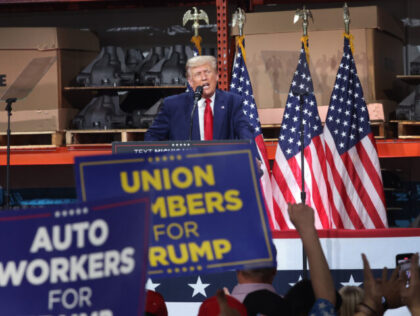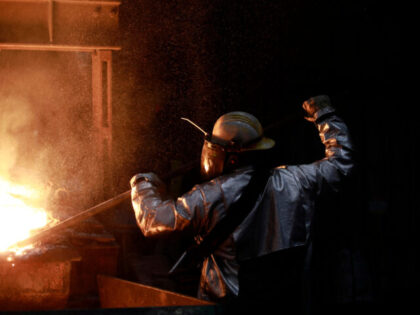Fact Check: Harris Misleadingly Claims Biden Added 800,000 Manufacturing Jobs
Harris wants credit for creating jobs that came back when lockdowns were lifted.

Harris wants credit for creating jobs that came back when lockdowns were lifted.

Ohio GOP Senate nominee Bernie Moreno told Breitbart News Daily that Sen. Sherrod Brown (D-OH) “is the grim reaper of manufacturing in Ohio.”

Unexpected weakness in a key economic bellwether.

Despite Kamala Harris’s claims, manufacturing employment is shrinking, and the manufacturing sector has been contracting.

Harris and Biden keep making the same misleading and false claims about the state of American manufacturing.

The manufacturing sector is actually in a serious slump deep enough that it threatens the labor market, the construction sector, and growth in the broader economy.

Is the U.S. manufacturing sector expanding or contracting? It depends who you ask.

Factory orders keep rising and orders for consumer goods are rising even faster.

Ohio Republican Senate candidate Bernie Moreno said Saturday that Ohio has forfeited 200,000 manufacturing jobs since his opponent, Sen. Sherrod Brown (D-OH), began serving in Congress.

Virginia U.S. Senate candidate and retired U.S. Navy captain Hung Cao earlier this month toured a nearly-finished state-of-art nitrile rubber plant in southwest Virginia that President Joe Biden’s administration has abandoned, allowing China to be on track to become America’s largest supplier of rubber medical gloves, he told Breitbart News in an exclusive interview.

The Biden administration is letting yet another factory languish that was meant to provide America with critical medical supplies instead of relying on China in the event of another national emergency.

China’s effort to jump-start its economy by exporting a vast quantity of cheap manufactured products is running into unexpected resistance from the United States, European Union, and even developing nations such as Brazil and Mexico. All of these nations are concerned with market disruptions caused by a tidal wave of Chinese imports, as happened during the “China Shock” two decades ago.

After 16 months in contraction, the ISM manufacturing survey unexpectedly popped into positive territory.

Factory output is down from a year ago but mining—including oil and gas drilling—is up.

President Joe Biden’s State of the Union (SOTU) speech included a brief mention of China, but the language was carefully trimmed to avoid saying anything that might offend Beijing, beyond the most cursory mention of Taiwan.

“Firms are consequently investing in more staff and more equipment, laying the foundations of further production gains in the coming months to hopefully drive a stronger and more sustainable recovery of the manufacturing economy,” S&P Global’s economist said.

The manufacturing sector is hitting a note that’s been sorely missed in recent acts: the sound of recovery.

A new study has identified the cities across the U.S. that are most and least at risk of losing jobs to artificial intelligence. According to the report, residents of Providence, Rhode Island, and Hartford, Connecticut are most at risk of being replaced in the workforce by AI.

The business conditions index falls to the lowest level since the pandemic-stricken months of 2020.

The manufacturing sector continued to contract in December, a closely watched economic barometer from the Institute for Supply Management indicated on Wednesday.

Chinese censors on Wednesday quickly deleted an article in a maternity-related news service that leaked plummeting birth rate data for 2023, revealing China’s population crisis is even worse than the regime has previously admitted.

The N.Y. Fed’s “Empire State” manufacturing index sank to -14.5 in December, the lowest level in four months.

Core capital goods orders were down for the second straight month in October, a signal of weakening business confidence in the economy.

China’s manufacturing activity slowed again in November, casting a pall over what the state-run Global Times awkwardly dubbed “Xiconomics,” the economic agenda of dictator Xi Jinping.

Orders are down. Employment is soft. Production is falling.

It is increasingly clear that the manufacturing sector rebounded in September.

A Pennsylvania woman has been awarded $7.1 million in a lawsuit against Conagra Brands after she was badly injured when a can of the manufacturer’s commercial cooking spray ignited and set her aflame.

China’s manufacturing activity crashed in October, posting numbers far lower than the slight dip many outside observers expected.

The Empire State manufacturing index has turned extremely volatile during the Bidenflation era.

The Commerce Department’s monthly report on factory orders is the latest evidence that U.S. manufacturing has bottomed and may even be rebounding.

A much stronger than expected report adds to the evidence that manufacturing’s slump is in the rearview mirror.

The U.S. manufacturing sector’s worst days appear to be behind it.

While Senator Tim Scott declared from the Reagan Library that union demands for higher pay and shorter work weeks “will not stand,” Donald Trump told workers in Michigan that “we love being with you.”

The latest Federal Reserve regional manufacturing surveys provide growing evidence that the manufacturing sector is rebounding.

Factory activity picked up even as businesses say they are facing stiff wage pressures and a deteriorating business climate.

Manufacturing remains in contraction, although the pace of the decline has eased. Services came closer to the threshold indicating a decline in activity.

Toyota, one of the world’s leading automakers, recently had to suspend operations in 12 of its 14 Japan-based factories due to a massive IT failure, resulting in a daily production loss of approximately 13,000 cars. The problem? The carmaker ran out of hard drive space.

Excluding transportation, manufacturing orders grew by more than expected.

The Dallas Fed’s barometer of activity in the Texas manufacturing sector showed contraction for the 16th straight month.

Another sign that the economy is not cooling off despite Federal Reserve rate hikes.
